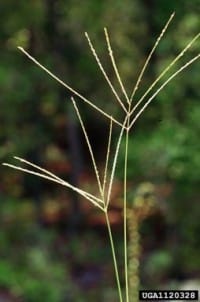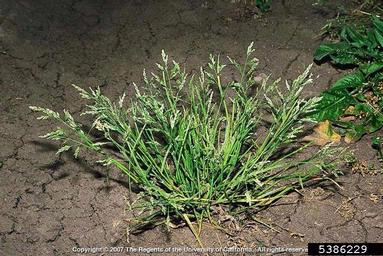Patrick McCullough, Extension Weed Specialist, University of Georgia
Annual weeds establish from seed and complete their lifecycle in one year. Summer or warm-season annual weeds (like crabgrass) establish in spring, grow actively in summer, and die out in fall. Winter or cool-season annual weeds (like annual bluegrass) establish in fall, grow from fall to spring, and complete their lifecycle in warm temperatures in late spring.
Failure to control annual weeds in late summer may predispose turfgrasses to winter weed infestations. In many lawns, it is fairly common to see turf with significant summer crabgrass populations have problems with annual bluegrass in fall. Open areas left in turf where crabgrass was once actively growing may permit annual bluegrass invasion during periods of peak seed germination. Controlling crabgrass now or in late summer could significantly improve turf cover, growth, and competition with annual bluegrass. See Table 1 for postemergence herbicide selection for crabgrass control in turf.
Late Summer Crabgrass Control Can Improve Annual Bluegrass Control This Fall

Quinclorac is a popular postemergence herbicide selection for crabgrass control in bermudagrass, zoysiagrass, and many cool-season grasses.
Single applications of quinclorac have excellent activity on mature, multi-tiller crabgrass plants at the seedhead stage in late summer. Bermudagrass, creeping bentgrass, perennial ryegrass, tall fescue, and zoysiagrass can be safely seeded seven days after a quinclorac application. Quinclorac requires the addition of an adjuvant, such as crop oil or methylated seed oil, for best results in established turf.
Mesotrione (Tenacity) can be used for postemergence crabgrass control in centipedegrass, perennial ryegrass, St. Augustinegrass, and tall fescue.
Mesotrione should be applied with a nonionic surfactant and will require two applications at a three week interval for late summer crabgrass control. These turfgrasses can also be safely established following mesotrione applications for crabgrass control. Currently, Tenacity can be used in nonresidential turf but will have residential lawns added to the label in the near future.
Fenoxaprop (Acclaim Extra) is a postemergence grassy weed herbicide for use in tall fescue, perennial ryegrass, and zoysiagrass.
Fenoxaprop has excellent activity on multi-tiller crabgrass with one application but efficacy is often reduced when crabgrass has seedheads present. Tall fescue and perennial ryegrass may be safely reseeded immediately after fenoxaprop applications. Late summer seeding of zoysiagrass is not recommended but newly plugged or sodded zoysiagrass may be treated with fenoxaprop.
Other herbicides for postemergence crabgrass control in centipedegrass, such as clethodim (Envoy) and sethoydim (Segment, others) may require two treatments at three to four week intervals to control mature, multi-tiller crabgrass.
These herbicides should not be used in centipedegrass lawns with significant bermudagrass infestations due to sensitivity and excessive injury to bermudagrass. Early fall seeding of centipedegrass is not recommended but turf managers should modify cultural practices to encourage turf to fill in areas where crabgrass was present before annual bluegrass begins to germinate.
Late Summer Cultural Practices to Reduce Annual Bluegrass Competition

Promoting turfgrass recovery from summer stress is critical to reduce annual bluegrass competition in fall.
Review cultural practices and make modifications if needed for lawns with crabgrass problems during summer months.
Mowing height significantly influences turfgrass competition with crabgrass, annual bluegrass, and other problem weeds.
Height of cut for most lawns should be no less than two inches. Raising the mowing height of tall fescue, for example, to three inches may significantly reduce annual bluegrass establishment in fall and reduce the need for postemergence herbicides in spring. Check mowing height for your turf-type.
Mowing frequency also influences turfgrass growth and susceptibility to annual bluegrass infestations.
Turf managers should mow lawns at least once per week during periods of vigorous growth to prevent scalping. Scalping thins out turf and may enable annual bluegrass establishment in open areas. While returning clippings is recommended to recycle nutrients to the soil, removal of clippings may be useful when annual bluegrass is present and producing seed heads. Removing clippings at this time will reduce the spread of viable seed through the lawn.
Encouraging turf recovery from summer stress may include modifications to fertilization programs.
Turf managers should consider reducing nitrogen fertilization during peak annual bluegrass germination and during periods of vigorous growth (cool weather). High nitrogen at these times encourages annual bluegrass spread and survival into winter and spring. Fertilizing dormant turfgrasses when annual bluegrass is actively growing will make these weed infestations worse.
Fall aerification of cool-season grasses may also influence annual bluegrass infestations.
Open areas of bare soil in turf following an aerification may encourage annual bluegrass infestations during periods of peak seed germination. Time aerifications in early fall to allow turf to recover before annual bluegrass germinates.
